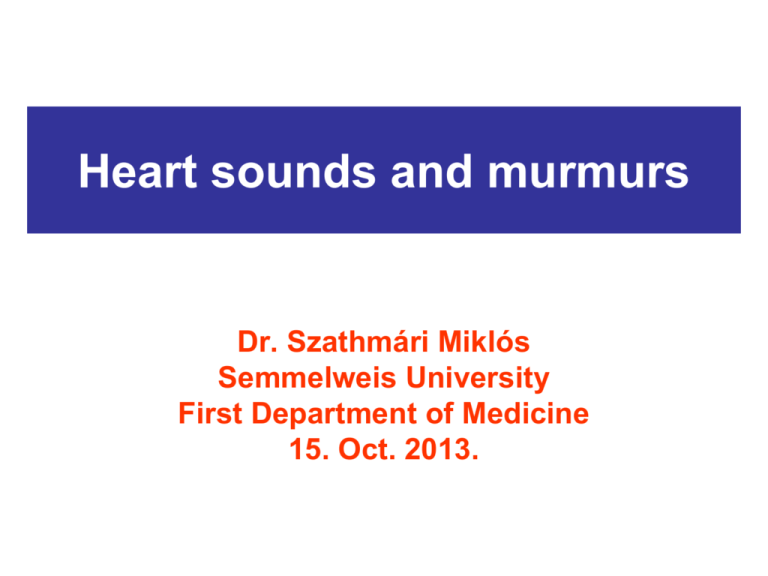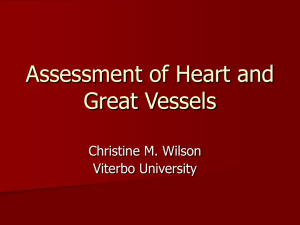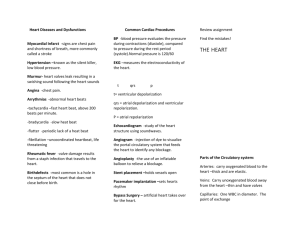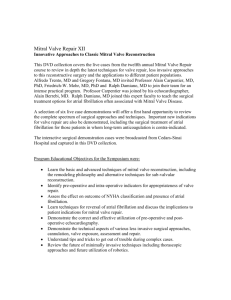Auscultation of the heart
advertisement

Heart sounds and murmurs Dr. Szathmári Miklós Semmelweis University First Department of Medicine 15. Oct. 2013. Conditions for auscultation of the heart • • • • Quiet room Patient comfortable Chest fully exposed Examiner on the right side of the patient Auscultation of the heart Auscultation of the heart APEX – MITRAL VALVE to left ventricle fifth intercostal space (left midclavicular line) Auscultation of the heart APEX – MITRAL VALVE to left ventricle fifth intercostal space (left midclavicular line) Auscultation of the heart TRICUSPID VALVE to right ventricle: fourth intercostal space (lower left sternal border) APEX – MITRAL VALVE to left ventricle fifth intercostal space (lateral to left midclavicular line) Auscultation of the heart TRICUSPID VALVE to right ventricle: fourth intercostal space (lower left sternal border) APEX – MITRAL VALVE to left ventricle fifth intercostal space (left midclavicular line) Auscultation of the heart PULMONARY VALVE: Second intercostal space (left upper sternal border) TRICUSPID VALVE to right ventricle: fourth intercostal space (lower left sternal border) APEX – MITRAL VALVE to left ventricle fifth intercostal space (left midclavicular line) Auscultation of the heart PULMONARY VALVE Second intercostal space (left upper sternal border) TRICUSPID VALVE to right ventricle: fourth intercostal space (lower left sternal border) APEX – MITRAL VALVE to left ventricle fifth intercostal space (left midclavicular line) Auscultation of the heart AORTIC VALVE (to aorta): second intercostal space (right upper sternal border) - outflow TRICUSPID VALVE to right ventricle: fourth intercostal space (lower left sternal border) PULMONARY VALVE Second intercostal space (left upper sternal border) APEX – MITRAL VALVE to left ventricle fifth intercostal space (left midclavicular line) The sounds ↔ The murmurs are generated by the beating heart, the valve movements, and the flow of blood through the heart. ~ called a heartbeat. are generated by turbulent flow of blood, which may occur inside or outside the heart. The sounds ↔ The murmurs • Brief • Discrete • Characterized by – Intensity (loudness) – Frequency (pitch) – Quality (timbre) • Prolonged • Characterized by – – – – – – Intensity (loudness) Frequency (pitch) Configuration (shape) Timing Duration Direction of radiation Normal heart sounds First heart sound (S1) Lub Closure of the mitral and tricuspidal valves Start of the systole Second heard sound (S2) Dub Closure of semilunar valves Start of the diastole Identification of heart sounds The systolic sound (S1) longer, deeper and softer, than S2 (beat-like, dobbanás-szerű). The diastolic sound (S2) is shorter, higher, and sharp (clicking-like, koppanás-szerű) • The diastolic interval (S2 – S1) is longer, than the systolic (S1-S2) • The carotid artery pulse or apical impulse occur in early systole, right after the first heart sound • S1 is usually louder than S2 at the apex, and S2 is usually louder than S1 at the base. Factors affecting the intensity of S1 Loud S1 Soft S1 • Short PR interval • Tachycardia/hyperkinetic state • Mitral stenosis • „Stiff” left ventricle • Holosystolic mitral valve prolapse • Long PR interval • Depressed LV contractility • Premature closure of mitral valve (ac. AR) • LBBB • Extracardiac factors Components of S2 (dub) (1) closure of the aortic valve: The aortic component (A2) is louder. It is heard throughout of the precordium. (2) closure of the pulmonary valve: The pulmonic component (P2) is softer. It is heard best in the 2nd and 3rd interspaces close to the sternum. In this location you should search for splitting of the second heart sound. Splitting of the second heart sound • Non-fixed • Fixed Lub-Drub Splitting of the second heart sound Non-fixed Inspiration negative intrathoracic pressure increased blood return into the right side of the heart the pulmonary valve stays open longer during ventricular systole increased delay in the P2 component of S2 relative to the A2 • • physiological in younger people During expiration, the interval between the two components normally shortens and the S2 sounds becomes merged. Splitting of the second heart sound Fixed Atrial (ASD) or ventricular septal defect (VSD) left to right shunt increases the blood flow to the right side of the heart (independent of inspiration/expiration) the pulmonary valve stays open longer during ventricular systole Third heart sound S3 • = protodiastolic (early diastolic) sound • not of valvular origin • occurs at the beginning/middle of diastole • occurs when the left ventricle is not very compliant, and at the beginning of diastole the rush of blood into the left ventricle causes vibration of the valve leaflets and the chordae tendinae. • It is heard best at the apex in the left lateral position. It is louder on inspiration. Dull, low – pitched. Third heart sound S3 • normal in children and young adults, but disappears before middle age. • abnormal re-emergence of this sound late in life indicates a pathological state: – failing left ventricle as in dilated congestive heart failure (CHF). – This sound is called a protodiastolic or ventricular gallop, a type of gallop rhythm • lub-dub-T (Kentucky; S1-S2-S3) Fourth heart sound S4 • • • • rare sometimes audible in healthy children in adult is called a presystolic (atrial) gallop. corresponds to ventricular filling caused by atrial contraction ("atrial kick") • a sign of a pathologic state: LVH, AS, HT • the sound of blood being forced into a stiff/hypertrophic left ventricle. • dub-de-lub (Tennessee; S2-S4-S1) dub-de-lub Tennessee Extra heart sounds – the „clicks” Systolic sounds Diastolic sounds Early Mid/late Early Mid/late Ejection clicks: aortic pulmonary Mitral valve prolapse Opening snap S3 and S4 High in pitch, have a sharp, clicking quality A/P stenosis Hypertension Abnormal systolic ballooning of part of the mitral valve into the left atrium Mitral valve stenosis Sounds - summary • S1 – closure of AV valves • S2 – closure of semilunar valves – Splitting (fixed-pathological, non-fixed-normal) • S3 – rapid filling phase of ventricle – Ventricular gallop - HF • S4 – ventricular filling during atrial contraction – Atrial gallop – LVH, AS, HT, CHD • Extra sounds – clicks – systolic: AS/PS/MVP – Diastolic: OS Murmurs Loud murmurs essentially always reflect a problem BUT Most heart problems do not produce any murmur! Gradations of murmurs Grade Grade 1 Grade 2 Grade 3 Grade 4 Grade 5 Grade 6 Description Very faint, heard only after listener has "tuned in"; may not be heard in all positions. Quiet, but heard immediately after placing the stethoscope on the chest. Moderately loud. Loud, with palpable thrill. Very loud, with thrill. May be heard when stethoscope is partly off the chest. Very loud, with thrill. May be heard with stethoscope entirely off the chest. Shapes of the murmurs • CRESCENDO • DECRESCENDO • CRESCENDODECRESCENDO – diamond • PLATEAU (EVEN) Murmurs „Physiologic” Innocent • Turbulent blood flow in children & young adults • Midsystolic • Lower left sternal border • Grade 1 to 2, medium pitch, usually decreases or disappears on sitting • Anaemia, fever, pregnancy, hyperthyroidism • Midsystolic • Aortic area Pathologic Pathologic murmurs Systolic Aortic stenosis Mitral regurgitation Diastolic Aortic regurgitation Mitral stenosis Systolo-diastolic (continuous) Pericardial friction rub Patent ductus arteriosus Interventions that influence the intensity of heart murmurs and sounds Respiration (inspiration) Right-sided murmurs increase Valsalva manoeuvre Most murmurs decrease in length and intensity. Exceptions: systolic murmur of HCM and mitral valve prolapse Exercise Most murmurs become louder (PS, MS, AR, MR, VSD). Exception: systolic murmur of HCM decreases with near max. handgrip exercise. Positional changes With standing Most murmurs diminish, exceptions: HCM and MVP Left lateral position Left-sided S3 and S4 and mitral murmurs are accentuated Sitting and leaning forward Accentuate of murmurs of aortic stenosis and aortic regurgitation Pericardial friction rub • It is a characteristic scratching, creaking, highpitched sound coming from the rubbing of both layers of inflamed pericardium. • It is the loudest in systole, but can often be heard also at the beginning and at the end of diastole. • It is very dependent on body position and breathing, and changes from hour to hour.






